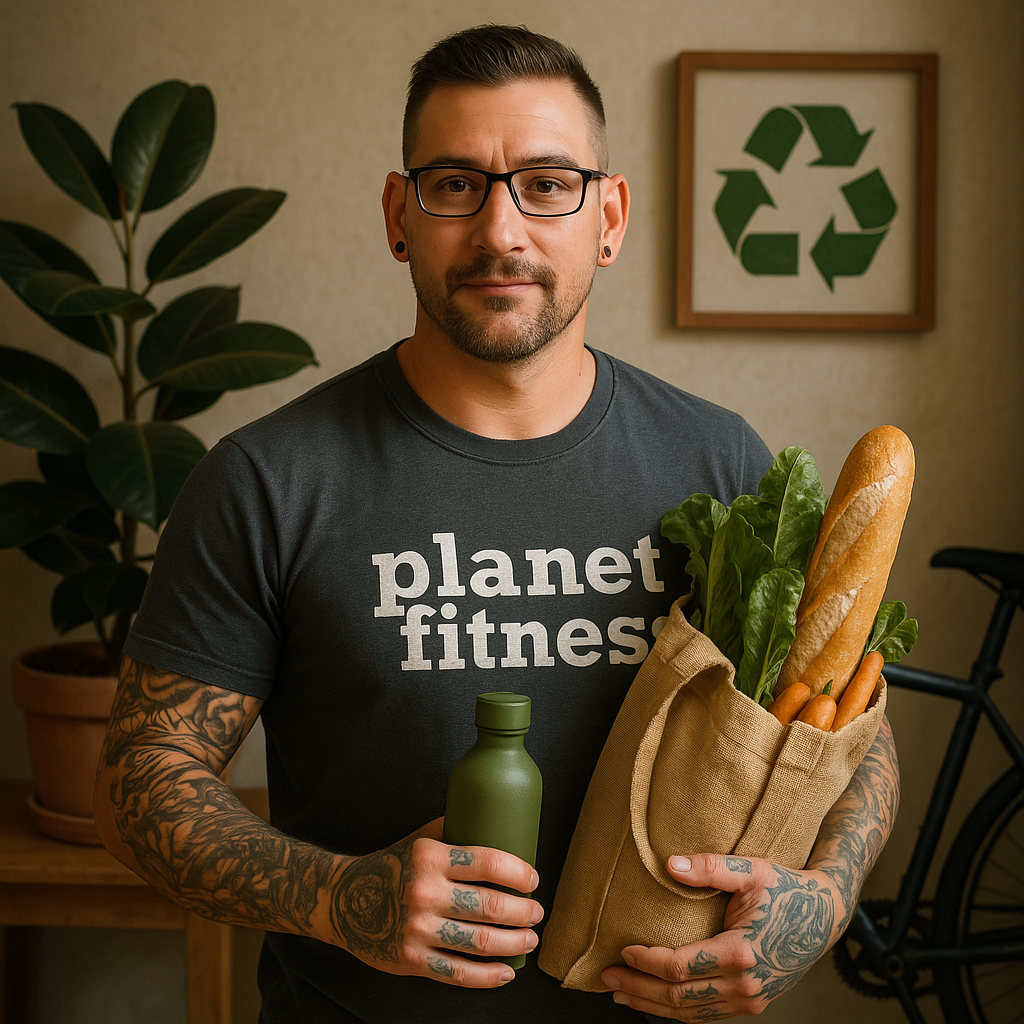

As a Tattoo Artist Dad, if you had told me ten years ago that I’d be separating compost from recyclables, swapping paper towels for cloth rags, or trading plastic grocery bags for a canvas tote, I probably would’ve laughed and taken a drag off my cigarette. I wasn’t what you’d call “eco-conscious.” Hell, I wasn’t even conscious before noon. Life was a chaotic blur of tattoo ink, late nights, and corner-store burritos.
But fatherhood changes you. Big time. And not just in the ways you expect.
Becoming a dad pulled my focus out of my own little world and into the one my kids are inheriting. That’s when the thought hit me: What kind of planet am I handing over to them? That was the start of my journey into sustainable living — not as some trendy minimalist influencer, but as a regular guy with four kids, bills to pay, and a deep desire to do better.
And here’s the kicker: I didn’t have to go broke doing it.
So, if you’ve ever thought about going green but felt overwhelmed by the cost, or if you’re just trying to find ways to live more intentionally without overhauling your entire life, this post is for you. Here’s how this tattooed dad from Las Vegas is making sustainable living work — and how you can, too.
Chapter 1: Why I Chose a Greener Life (and Why It’s Not Just for Hippies)
Let’s get this out of the way: sustainable living isn’t about being perfect. It’s about making better choices — a little bit at a time.
For me, the decision to live more sustainably wasn’t sparked by some Instagram challenge or a docuseries on deforestation. It came from watching my kids play in the backyard, knowing someday this world would be theirs. I wanted them to grow up in a cleaner, healthier world — not one filled with smog, trash islands, and chemical-laden everything.
But I also had to be real. I’m a working-class dad, a tattoo artist, and a guy who’s had his fair share of financial setbacks. I couldn’t afford solar panels or a Tesla. So I started small. And surprisingly, those small changes added up to something big — not just for the planet, but for my wallet, too.
Chapter 2: Sustainable Swaps That Save Money
Here’s a truth bomb: going green doesn’t mean spending green. In fact, a lot of eco-friendly habits are downright cheap — or even free. Here are a few of the changes I made that saved us money over time:
1. Ditching Disposable Products
What I used to do: Burn through paper towels, plastic sandwich bags, disposable razors, and takeout containers like they were going out of style.
What I do now: Use cloth rags (cut from old T-shirts), reusable silicone storage bags, a safety razor, and glass containers.
Savings: Over a year, we cut about $300 in household disposable purchases.
2. Swapping Out Plastic Bottles
I used to drink bottled water like it was holy. One day, I added up how much I was spending — over $500 a year just on plastic water bottles. So I bought a quality water filter and a few reusable bottles. Now, I save money and I’m not throwing away a dozen bottles a week.
3. Cooking More, Wasting Less
When I realized how much food we were tossing (and how much it cost), I started meal planning. Nothing fancy — just a whiteboard on the fridge and a little intention. I also learned to freeze leftovers and use “scrap” veggies for broth.
Savings: Easily $100/month on groceries.
Chapter 3: The Family Factor — Teaching Kids to Go Green
Having four kids means a lot of noise, messes, and love — and a huge opportunity to pass on good habits. I didn’t want to just model sustainable living; I wanted to involve my kids.
1. Recycling Becomes a Game
We created a simple color-coded system: green bin for recycling, blue for trash, and a compost jar under the sink. The kids got a kick out of sorting items — and I turned it into a game: “Who can find five recyclables today?”
2. Upcycled Art Projects
My kids love crafts. Instead of buying new supplies every month, we use toilet paper rolls, cereal boxes, broken crayons, and more to make cool projects. Bonus: less waste, more creativity.
3. Garden Time
We started a small herb garden — nothing fancy. Basil, mint, parsley. Just enough to let the kids dig in the dirt, watch something grow, and get excited about food from the earth instead of the store.
Chapter 4: Eco-Friendly Parenting on a Budget
Sustainable living as a parent can seem expensive — all those organic cotton baby clothes, bamboo diapers, and eco toys come at a premium. But it doesn’t have to be that way.
Here’s how I kept things green without draining my bank account:
• Secondhand Wins: Facebook Marketplace, thrift shops, and hand-me-downs became my best friends. Clothes, furniture, toys — it’s all out there, barely used and way cheaper than new.
• Cloth Diapers (Sometimes): We didn’t go full cloth, but even part-time use saved money and reduced landfill waste.
• DIY Baby Wipes: Water, a little baby soap, and soft flannel rags worked wonders. Cheap and gentle.
Chapter 5: How My Tattoo Studio Went a Little Greener
Running a tattoo studio means dealing with a lot of single-use items — needles, gloves, razors — for hygiene reasons. But that doesn’t mean there’s nothing I can do.
Eco-friendly moves I’ve made at the shop:
• Biodegradable razors instead of plastic disposables
• Eco paper towels made from bamboo or recycled content
• LED lighting throughout the shop
• Recycled paper for consent forms and flyers
• Digital waivers when possible to cut paper use
I even switched to a green-certified cleaning solution that works just as well as the harsh stuff — without the chemical stink.
Chapter 6: Green Cleaning Without the Green Price Tag
One of the sneakiest expenses in any household? Cleaning supplies. I used to buy into the lie that you needed one product for every surface. Now I make most of my own — for pennies.
My go-to DIY cleaner recipe:
• 1 part vinegar
• 1 part water
• A few drops of essential oil (tea tree, lemon, or lavender)
Use it on: counters, mirrors, bathroom tiles, even toys.
Other cheap swaps:
• Baking soda for scrubbing tubs
• Microfiber cloths instead of Swiffer pads
• Reusable mop head with vinegar spray
We save about $250/year with these changes alone — and my house smells like an essential oil shop.
Chapter 7: Sustainable Food Choices That Won’t Bankrupt You
Everyone’s preaching “organic everything,” but when you’ve got a big family, that can be wildly expensive. Here’s how I strike a balance:
1. Dirty Dozen, Clean Fifteen
I focus on buying organic for the “Dirty Dozen” (produce most likely to carry pesticides) and save money by buying conventional for the “Clean Fifteen.” That alone cut our grocery bill while keeping us safer.
2. Meatless Mondays
We cut meat one day a week and swapped in lentils, beans, or tofu. Cheaper, healthier, and better for the planet.
3. Cook Once, Eat Twice
Big pots of chili, soup, or pasta go a long way. I freeze half for a busy night and avoid fast food — another win for our wallet and our waste output.
Chapter 8: The Unexpected Benefits of Sustainable Living
Aside from saving money and feeling like I’m doing right by the earth, I’ve noticed some surprising benefits:
1. Less Stress
Seriously. Clutter stresses me out. Having fewer disposable things lying around, organizing more intentionally, and owning less “stuff” has made our home feel calmer.
2. Stronger Family Bond
Getting the kids involved in gardening, cleaning, and upcycling has given us more quality time together. They’re learning life skills and we’re making memories.
3. Sense of Purpose
There’s something deeply grounding about living with intention. Every little change feels like a small act of rebellion against wastefulness.
Chapter 9: What You Can Do — Starting Today
If you’ve read this far, chances are something’s clicked. Maybe you’ve been thinking about making some changes but didn’t know where to start. Good news: you don’t need to overhaul your life.
Here are 20 quick wins to jumpstart your sustainable journey:
1. Switch to a reusable water bottle
2. Bring your own bags to the store
3. Try meatless Mondays
4. Buy secondhand before buying new
5. Use cloth napkins instead of paper
6. Start composting (even a small bin helps)
7. Make your own cleaning spray
8. Replace old bulbs with LEDs
9. Unplug chargers when not in use
10. Fix things instead of tossing them
11. Buy in bulk to reduce packaging
12. Donate or repurpose old clothes
13. Support local farmers markets
14. Use bar soap instead of bottled
15. Skip fast fashion — opt for thrift
16. Wash clothes in cold water
17. Hang dry when possible
18. Get a library card instead of buying books
19. Refill containers at refill stores
20. Talk to your kids about sustainability
Final Thoughts: Progress, Not Perfection
If there’s one thing I’ve learned on this journey, it’s that you don’t need to be perfect to make a difference. I still use the occasional plastic item. Sometimes we grab fast food. Life gets busy, and being a parent means you do what you can with the time and energy you’ve got.
But every step counts.
Living sustainably doesn’t mean abandoning modern life or breaking the bank. It means being intentional. Thoughtful. And creative — something I think tattoo artists and parents alike have in spades.
So if you’re feeling inspired, start small. Swap one habit. Involve your kids. Reuse something you thought was trash. And don’t beat yourself up when you slip.
You’re not just helping the planet — you’re building a better world for your kids.
And trust me — that’s the most badass legacy you can leave behind.
- Size: 16″x54″
- Design is not reversible
- Runner has a 100% cotton lining
- 📷WIDE AND COMFORTABLE : The camera strap is made of high quality cotton, retro embroidery process , 2” (5 cm) ultra-wide…
- 📷STURDY AND DURABLE: Both end of the camera strap are made of double-layer high-quality cowhide, which is not easy to de…
- 📷ADJUSTABLE – The camera strap adopts an adjustable design, camera strap measures a Minimum 32”(82cm)Long,Max Size: 61”(…



